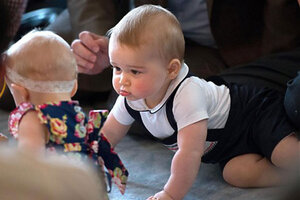Royal baby due date: Could Will & Kate's second child take the throne?
Royal baby due date: Prince William and Kate Middleton are expecting their second baby next April. The child is dubbed 'spare to the heir' in royal parlance. How likely is it that Baby No. 2 could assume the British throne?

Britain's Prince George in April 2014, right, plays during a visit to Plunket nurse and parents group at Government House in Wellington, New Zealand. He will soon have a new brother or sister.
(AP Photo/Marty Melville, Pool, file)
Prince William and Kate Middleton will be welcoming a second baby in April, Britain's royal family announced Monday.
While the gender of baby No. 2 remains unknown, the Duke and Duchess of Cambridge ruled out the possibility of twins with the use of the word "baby," thereby dodging a sensitive successor situation.
“Their Royal Highnesses The Duke and Duchess of Cambridge are delighted to confirm they are expecting a baby in April 2015,” palace officials wrote in the press release.
With Prince George only 15 months old, and already positioned for the throne, why the rush to have baby No. 2?
In royal parlance, the second-born is called "the spare to the heir," and fills a different – if still vital – role in the royal family, or any monarchy for that matter.
William and Kate's forthcoming baby, regardless of its gender, will be fourth in line to the throne, following Prince Charles, Prince William, and Prince George.
Historically, monarchs ensured they would have sufficient successors to the throne by having a veritable legion of children (Queen Victoria had nine children, while King George III had thirteen.). That was because fatal childhood illnesses and infighting was once common, which meant many royal children never actually made it to adulthood, or to the throne.
In fact, many famous monarchs have been second- or third-born children.
Henry VIII, one of the most notorious English monarchs, known for his six tumultuous marriages and for separating the Church of England from the Pope and the Roman Catholic Church, was a second son who ascended the throne at 17 after his brother Arthur's mysterious death. George V, who ruled during the first World War, was also a second son and became heir after his older brother died from influenza.
Richard I of England, better known as "Richard the Lionheart," who made his name as a king who fought in the Crusades, was originally third in line for the throne.
And it's not just kings of old – even George VI, the current Queen of England's father, is a second-born son who was never meant to be king. He came to the throne in a unique way. King George's elder brother, Edward VIII, gave up the throne in 1936 to marry Wallis Simpson, an American divorcee, leaving the very surprised second-born son, who had been Prince Albert, Duke of York, as the king of England. Prince Albert, who was severely shy and suffered from a serious stammer, ultimately went on to play an important role in WWII and become a much-loved king. His story was chronicled in 2010 film "The King's Speech."
So even though baby George is already positioned for the throne, his younger brother or sister will fill an important role as the "heir's spare."
Of course, royal infighting and fatal illness are less common today than they once were, so baby No. 2 may never see the throne. Even then, he or she may be saddled with a share of the many royal duties and obligations – think royal visits, receptions, charities, trips.
Another difference in the modern-day monarchy: The spare heir - and heir, for that matter - can be female. That's thanks to a 2013 law that changed the previous male-centric ruling by allowing women the same rights to accession to the throne as men. So even if George's younger sibling is a sister, she will still be fourth in line to the throne.


